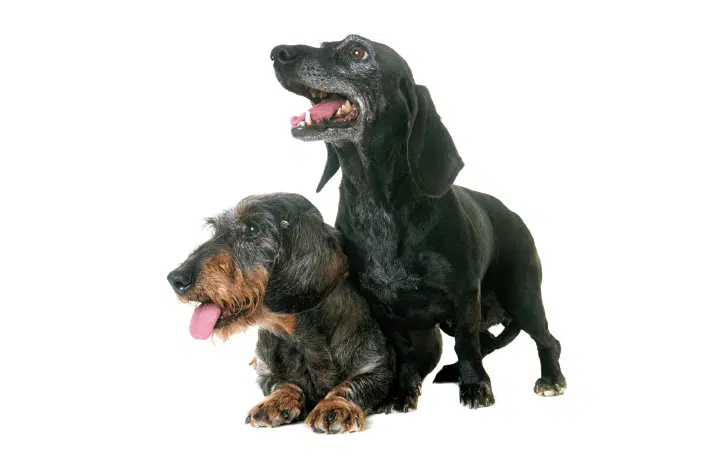Just as human life expectancy is continuously increasing, so it is for our closest companions as well. Canine and feline life expectancy has been increasing over the past decade due to improved nutrition and readily available veterinary care, but most of all due to an increased awareness of our pet’s needs. Today, we take better care of our pets, not because we care more, but because we are better educated. Helping your pet age gracefully is part of that process.
When does your pet qualify as a senior?
Smaller dog breeds usually outlive their larger cousins by a significant margin. The lifespan of large-breed dogs is estimated to be around seven to eight years, while small and toy breeds generally live approximately 12 years. So, small breeds of dogs are considered senior at age 10, while giant breeds are seniors as early as five years of age. Cats, on the other hand, show no breed effect when it comes to ageing. Cats enjoy an average life expectancy of around 14 years and are generally considered senior at an age of 11 years.
Visible signs of ageing in pets are often recognised as impairment or loss of senses, slower and more difficult movement, grey and thinning hair, and an overall loss of condition. These external signs are the visual manifestation of a host of physiological changes and/ or slowing of processes and, in some unfortunate cases, system malfunction.
How can we help our pets age gratefully?
Keep them active
As our pets age, it is important to keep them active. Activity stimulates blood flow and metabolism, which helps manage weight and cognitive (mental) health – just as it does in humans. One of the worst things we can do as we age is to abandon exercise or stop communicating and learning. When we do, we accelerate the decline of our overall health and wellbeing. The same is true for our pets. If we keep them active and continue teaching them new tricks, they’ll stay much more physically fit and mentally alert as they age.
Feed a diet that is rich in energy
Nutrition plays a key role in an animal’s cognitive health as well as keeping their natural barriers in good condition. A large portion of our pet’s brain consists of soft, fatty tissue that’s cholesterol dependent. Cholesterol is an essential component of cell membranes and helps cells communicate. One reason pet health often declines with age is due to a failure to maintain body weight in the geriatric years. It’s not uncommon for dogs and cats in their middle years to gain weight, but when they get older, they often begin to lose weight. A higher-fat, higher-energy diet, including omega-3 fatty acids (EPA & DHA) in the geriatric years may help pets stay more alert, improve focus and help them better remember things like training commands, a favourite park, or where the litter box is located.
Provide highly available sources of trace minerals
By providing your senior pet with the correct regimen of essential minerals, gradual degradation of key processes can be slowed, helping your pet to age gracefully. One of the most important minerals in all life stages is zinc.
Zinc is involved in more than 300 enzyme systems and plays an important role in more than 3 000 proteins involved in important biological functions, which become more critical as an animal ages. These include immune function, neurotransmission, vision, epithelial tissue integrity, and intestinal ion transport. Moreover, zinc plays a key role in mental activity, focus, emotional behavior, learning, and memory as it’s a key component in the development of brain tissue and signaling. Interestingly, if zinc intake and retention are insufficient, an animal will begin to break down protein to maintain zinc status, even if protein intake is sufficient. This, in addition to an age-related decline in nutrient absorption efficiency, may further explain the weight loss we see in senior animals. Ensuring a sufficient supply of zinc is paramount to supporting your pet’s health and well-being as they age.
As mentioned in a previous article in the March issue of the PFI Newsletter, entitled: “Trace minerals and inflammation in cats and dogs”, the epithelial tissues lining the gut are an extremely important barrier that prevents bacteria, pathogens, and toxins, which occur naturally in the gut, from passing through the intestinal lining into the bloodstream and causing inflammation. It is a well-known fact that the gut epithelial lining has a
very high rate of cell turnover and, without effective cell mitosis, in which a number of zinc-dependent enzymes are involved, the integrity of this lining may become comprised. The same is also true for skin. Skin cells are constantly being replaced from deeper epithelial skin layers, as the keratinised outside layers are continuously being shed. Without optimal cell mitosis, breaks in the skin can start to occur. This can cause scaly, itchy, and inflamed patches of skin, a rough or dull coat, and hair loss.
Choosing the right zinc source
Recent research conducted by Irish and German researchers (Sauer et al., 2017) helps us better understand why bioavailability and performance of
trace minerals depend on source. Their work looked at different trace mineral absorption pathways used by gut enterocytes for zinc absorption. In one model, they utilised human enterocytes, differentiated by mutations in ZIP4, an important zinc ion transporter, for uptake into the gut lining. In cells without ZIP4 capability, no impairment in zinc absorption occurred when zinc was presented as a zinc amino acid complex (ZnAA), while zinc absorption was inhibited when the source was ZnCl2. These findings demonstrate that ZnAA are taken up via an alternate absorption pathway than inorganic zinc. Therefore, metal amino acid complexes have an absorption advantage over inorganic mineral forms, as they are minimally antagonised by common dietary components such as phytic acid, fibre, or other inorganic minerals and use amino acid transporters instead of common metal ion transporters (Figure 1).

vs the metal ion transport pathway.
As part of a well-balanced diet for our senior pets, we recommend supplementing 100 ppm (mg/kg) of zinc in dry pet food. This will ensure an adequate supply of zinc to crucial tissues that will assist in helping your pet age gracefully.
Heinrich Jansen van Vuuren holds a BSc in animal science from the University of Pretoria and is the team lead for amino acids, companion animals, and aquaculture at Chemuniqué.











Excellent article: similar content could have been written for human nutrition, amazingly how similar the human digestive system of dogs is with the human digestive system! Raeely enjoyed this article. Well done Cinzia!
Pleased you liked it Jerry, credit to Dana and Heinrich whom where also involved in creating the article. Indeed many additives and concepts in pet food are coming from human nutrition.